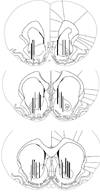Blunted cystine-glutamate antiporter function in the nucleus accumbens promotes cocaine-induced drug seeking
- PMID: 18601982
- PMCID: PMC2614296
- DOI: 10.1016/j.neuroscience.2008.06.010
Blunted cystine-glutamate antiporter function in the nucleus accumbens promotes cocaine-induced drug seeking
Abstract
Repeated cocaine alters glutamate neurotransmission, in part, by reducing cystine-glutamate exchange via system xc-, which maintains glutamate levels and receptor stimulation in the extrasynaptic compartment. In the present study, we undertook two approaches to determine the significance of plasticity involving system xc-. First, we examined whether the cysteine prodrug N-acetylcysteine attenuates cocaine-primed reinstatement by targeting system xc-. Rats were trained to self-administer cocaine (1 mg/kg/200 microl, i.v.) under extended access conditions (6 h/day). After extinction training, cocaine (10 mg/kg, i.p.) primed reinstatement was assessed in rats pretreated with N-acetylcysteine (0-60 mg/kg, i.p.) in the presence or absence of the system xc- inhibitor (S)-4-carboxyphenylglycine (CPG; 0.5 microM; infused into the nucleus accumbens). N-acetylcysteine attenuated cocaine-primed reinstatement, and this effect was reversed by co-administration of CPG. Secondly, we examined whether reduced system xc- activity is necessary for cocaine-primed reinstatement. To do this, we administered N-acetylcysteine (0 or 90 mg/kg, i.p.) prior to 12 daily self-administration sessions (1 mg/kg/200 microl, i.v.; 6 h/day) since this procedure has previously been shown to prevent reduced activity of system xc-. On the reinstatement test day, we then acutely impaired system xc- in some of the rats by infusing CPG (0.5 microM) into the nucleus accumbens. Rats that had received N-acetylcysteine prior to daily self-administration sessions exhibited diminished cocaine-primed reinstatement; this effect was reversed by infusing the cystine-glutamate exchange inhibitor CPG into the nucleus accumbens. Collectively these data establish system xc- in the nucleus accumbens as a key mechanism contributing to cocaine-primed reinstatement.
Figures





Similar articles
-
Cystine/glutamate exchange regulates metabotropic glutamate receptor presynaptic inhibition of excitatory transmission and vulnerability to cocaine seeking.J Neurosci. 2005 Jul 6;25(27):6389-93. doi: 10.1523/JNEUROSCI.1007-05.2005. J Neurosci. 2005. PMID: 16000629 Free PMC article.
-
Neuroadaptations in cystine-glutamate exchange underlie cocaine relapse.Nat Neurosci. 2003 Jul;6(7):743-9. doi: 10.1038/nn1069. Nat Neurosci. 2003. PMID: 12778052
-
Ceftriaxone restores glutamate homeostasis and prevents relapse to cocaine seeking.Biol Psychiatry. 2010 Jan 1;67(1):81-4. doi: 10.1016/j.biopsych.2009.07.018. Biol Psychiatry. 2010. PMID: 19717140 Free PMC article.
-
Brain-derived neurotrophic factor and cocaine addiction.Brain Res. 2010 Feb 16;1314:183-93. doi: 10.1016/j.brainres.2009.08.078. Epub 2009 Sep 2. Brain Res. 2010. PMID: 19732758 Free PMC article. Review.
-
Using glutamate homeostasis as a target for treating addictive disorders.Behav Pharmacol. 2010 Sep;21(5-6):514-22. doi: 10.1097/FBP.0b013e32833d41b2. Behav Pharmacol. 2010. PMID: 20634691 Free PMC article. Review.
Cited by
-
The effects of cocaine on different redox forms of cysteine and homocysteine, and on labile, reduced sulfur in the rat plasma following active versus passive drug injections.Neurotox Res. 2013 Oct;24(3):377-92. doi: 10.1007/s12640-013-9403-6. Epub 2013 May 16. Neurotox Res. 2013. PMID: 23677450 Free PMC article.
-
N-acetylcysteine decreased nicotine self-administration and cue-induced reinstatement of nicotine seeking in rats: comparison with the effects of N-acetylcysteine on food responding and food seeking.Psychopharmacology (Berl). 2013 Jan;225(2):473-82. doi: 10.1007/s00213-012-2837-3. Epub 2012 Aug 19. Psychopharmacology (Berl). 2013. PMID: 22903390 Free PMC article.
-
Chronic N-acetylcysteine during abstinence or extinction after cocaine self-administration produces enduring reductions in drug seeking.J Pharmacol Exp Ther. 2011 May;337(2):487-93. doi: 10.1124/jpet.111.179317. Epub 2011 Feb 8. J Pharmacol Exp Ther. 2011. PMID: 21303920 Free PMC article.
-
Glutamatergic medications for the treatment of drug and behavioral addictions.Pharmacol Biochem Behav. 2012 Feb;100(4):801-10. doi: 10.1016/j.pbb.2011.04.015. Epub 2011 Apr 22. Pharmacol Biochem Behav. 2012. PMID: 21536062 Free PMC article. Review.
-
Targeting redox regulation to treat substance use disorder using N‐acetylcysteine.Eur J Neurosci. 2019 Aug;50(3):2538-2551. doi: 10.1111/ejn.14130. Epub 2018 Sep 24. Eur J Neurosci. 2019. PMID: 30144182 Free PMC article. Review.
References
-
- Ahmed SH, Koob GF. Transition from moderate to excessive drug intake: change in hedonic set point. Science. 1998;282:298–300. - PubMed
-
- Aoyama K, Suh SW, Hamby AM, Liu J, Chan WY, Chen Y, Swanson RA. Neuronal glutathione deficiency and age-dependent neurodegeneration in the EAAC1 deficient mouse. Nat Neurosci. 2006;9:119–126. - PubMed
-
- Baker DA, Tran-Nguyen TL, Fuchs RA, Neisewander JL. Influence of individual differences and chronic fluoxetine treatment on cocaine-seeking behavior in rats. Psychopharmacology (Berl) 2001;155:18–26. - PubMed
-
- Baker DA, McFarland K, Lake RW, Shen H, Tang XC, Toda S, Kalivas PW. Neuroadaptations in cystine-glutamate exchange underlie cocaine relapse. Nat Neurosci. 2003;6:743–749. - PubMed
Publication types
MeSH terms
Substances
Grants and funding
LinkOut - more resources
Full Text Sources
Other Literature Sources
Medical

